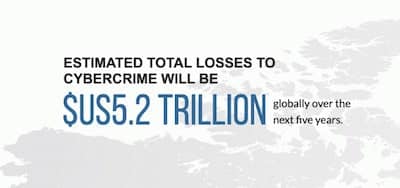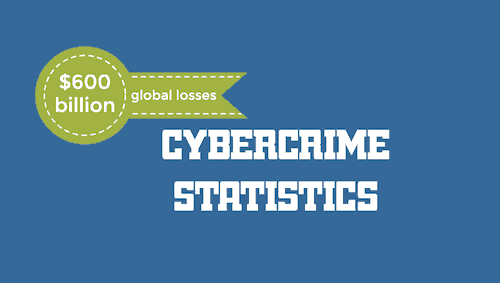Dig into these surprising, and sometimes shocking, cybercrime statistics to understand what’s going on globally. If you need help with cybercrime or online scams, our investigative department is at your assistance.
Cybercrime Statistics in 2019
- Information theft, loss, or attack is now the prevalent type of crime against organizations. Until 2017, physical theft was the most common type of fraud for decades. (ENISA Threat Landscape Report 2018)
- Malware samples grew from 137.5 million (AV-Test) in 2018 to 24.55 million new samples in 2019.
- In 2018, 93% of malware researched was polymorphic. This means the malware can continuously adjust its code to evade detection (2019 Webroot Threat Report)
- Over 50% of infected devices were re-infected within the same year (2019 Webroot Threat Report)
- Cybercrime now accounts for more than 50% of all crimes in the UK.
- Every 39 seconds, malicious hackers attack computers and networks (University of Maryland)
- 78% of surveyed organizations were affected by a successful cyberattack in 2018 (Imperva 2019 Cyberthreat Defense Report)
Cost of Cybercrime Statistics
The Annual Cost of Cybercrime study from Accenture showed that cyberattacks are evolving: how cybercriminals attack, the impact of their attacks, and how they change cybercrime methods. The varied ways in which cybercriminals amass these large sums of money range from massive operations to spray-and-pray attacks, the latter targeting a large number of victims in the hope that it will compromise some of them.

Accenture calculated a total value at risk of $US5.2 trillion globally over the next five years. Though it constitutes a relatively new criminal economy, cybercrime is already generating at least $1,5 trillion in revenues every year. According to McAfee, the cost of cybercrime is up to 0.8% of the world’s GDP.

Revenue generation in the cybercrime industry happens at a variety of levels. There are large ‘multinational’ operations that can generate profits of over $1 billion. Whereas with small-scale operations, earnings of $30,000- $50,000 are more the norm. – Bromium, Into The Web of Profit
Now you know how much money is lost to cybercrime. How do cybercriminals manage to move these massive sums of money without being caught? Money laundering studies show that at least 10% of the $1.6-$2 trillion laundered money worldwide comes from cybercrime. -Bromium, Into The Web of Profit
Cybercrime Identity Theft Statistics
From July 2018 to October 2018, Agari data found that 62% of all identity-deception based attacks leveraged name deception aimed at impersonating a trusted individual.
Q4 2018: Email Fraud and Identity Deception Trends by Agari
Stats on Cybercrime
• 2.1 trillion USD: The total global annual cost of all data breaches by 2019. (Juniper Research)
• 15 billion USD: the value of cryptocurrency stolen from online exchanges between 2012 and 2017 (2018 Trustwave Global Security Report)
• 12.5 billion USD: Financial losses due to business email compromise (BEC) and email account compromise (EAC) between October 2013 and May 2018 (Secure Works State of Cybercrime Report 2018)
• 5 billion USD: estimated damages from ransomware attacks in 2017 (Europol Internet Organized Crime Threat Assessment (IOCTA 2018)
• 3.25 billion USD: global revenue generated by social media-enabled crimes (Bromium Into The Web of Profit – Social Media Platforms and the Cybercrime Economy)
• 3.2 billion USD: global smart grid cybersecurity spending by 2026
• 1.7 billion USD: expenses by energy utilities in 2017 to protect their systems from cyber-attacks. (The Global Risks Report 2019 – World Economic Forum)
• 530 million USD: the cost of the January 2018 Coincheck hack, the biggest cryptocurrency heist to date. (Time Money)
1% of business executives who consider cybercrime the most disruptive fraud lost more than $100 million as a result (Global Economic Crime and Fraud Survey 2018 by PWC)
• 50 million USD: the total cost of cybercrime across 237 leading companies in 6 countries. (Micro Focus)
• 13.5 million USD (944 million rupees): the amount that an Indian bank lost “after hackers installed malware on its ATM server that enabled them to make fraudulent withdrawals from cash machines” (InfoSecurity Magazine)
• 4.6 million USD: losses due to a large-scale CEO fraud, caused by two individuals (Europol Internet Organised Crime Threat Assessment – IOCTA 2018)
• 3.8 million USD: the average cost of a data breach to a business. (Microsoft)
Cybercriminals can earn $2.2 million each month by buying only ten stolen credit cards from underground markets. Hence, why form jacking is making a rapid comeback as a preferred attack strategy (2019 Internet Security Threat Report by Symantec)
• 2 million USD: the average loss due to a DDoS attack on an enterprise in 2017 (Kaspersky)
• 660,000 USD per hour: these are losses due to e-commerce fraud (RSA 2018 Current State of Cybercrime)
• 500,000 USD: is the average damage 53% of attacks cause. (Cisco Annual Cybersecurity Report 2018)
While financial losses play a big part in the cost of cybercrime, research shows there are other losses as well. In the next two years, cybercrime is expected to be the most severe and disruptive economic crime for organizations. – Global Economic Crime and Fraud Survey 2018 by PWC
For more cybercrime statistics, see 300+ terrifying cybercrime and cybersecurity statistics & trends from CompariTech.



Trackbacks/Pingbacks